
The history of ancient Israel and Judah begins in the Southern Levant region of Western Asia during the Late Bronze Age and Early Iron Age. "Israel" as a people or tribal confederation appears for the first time in the Merneptah Stele, an inscription from ancient Egypt that dates to about 1208 BCE. According to modern archaeology, ancient Israelite culture developed as an outgrowth from the Semitic Canaanites. Two related Israelite polities known as the Kingdom of Israel (Samaria) and the Kingdom of Judah had emerged in the region by Iron Age II.
Judah or Yehuda is the name of a biblical patriarch, Judah. It may also refer to:

The Kingdom of Judah was an Israelite kingdom of the Southern Levant during the Iron Age. Centered in Judea, the kingdom's capital was Jerusalem. The other Israelite polity, the Kingdom of Israel, lay to the north. Jews are named after Judah and are primarily descended from it.
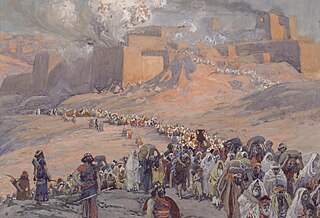
The Babylonian captivity or Babylonian exile is the period in Jewish history during which a large number of Judeans from the ancient Kingdom of Judah were captives in Babylon, the capital city of the Neo-Babylonian Empire, following their defeat in the Jewish–Babylonian War and the destruction of Solomon's Temple in Jerusalem. The event is described in the Hebrew Bible, and its historicity is supported by archaeological and extra-biblical evidence.
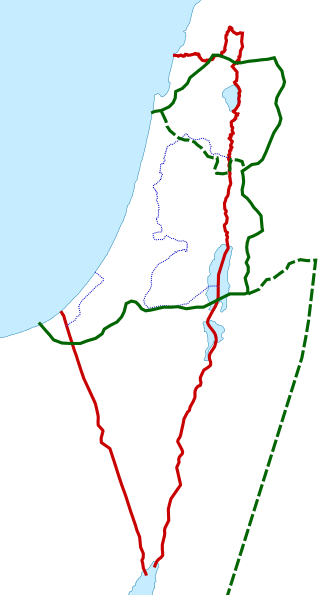
Palestine is a geographic region in Western Asia. It is usually considered to include Israel and the State of Palestine, though some definitions also include part of northwestern Jordan.
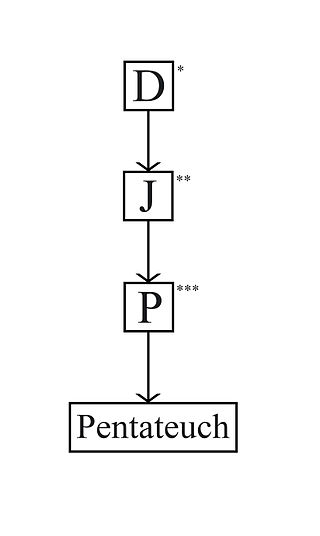
The Priestly source is perhaps the most widely recognized of the sources underlying the Torah. It is both stylistically and theologically distinct from other material in the Torah, and includes a set of claims that are contradicted by non-Priestly passages and therefore uniquely characteristic: no sacrifice before the institution is ordained by Yahweh (God) at Sinai, the exalted status of Aaron and the priesthood, and the use of the divine title El Shaddai before God reveals his name to Moses, to name a few. In general, the Priestly work is concerned with priestly matters – ritual law, the origins of shrines and rituals, and genealogies – all expressed in a formal, repetitive style. It stresses the rules and rituals of worship, and the crucial role of priests, expanding considerably on the role given to Aaron.

The Paleo-Hebrew script, also Palaeo-Hebrew, Proto-Hebrew or Old Hebrew, is the writing system found in inscriptions of Canaanite languages from the region of Southern Canaan, also known as biblical Israel and Judah. It is considered to be the script used to record the original texts of the Hebrew Bible due to its similarity to the Samaritan script, as the Talmud stated that the Hebrew ancient script was still used by the Samaritans. The Talmud described it as the "Libona'a script", translated by some as "Lebanon script". Use of the term "Paleo-Hebrew alphabet" is due to a 1954 suggestion by Solomon Birnbaum, who argued that "[t]o apply the term Phoenician [ancient Phoenicia or modern Lebanon being Northern Canaan] to the script of the Hebrews [ancient Israel-Judah or modern Israel/Palestine being Southern Canaan] is hardly suitable". The Paleo-Hebrew and Phoenician alphabets are two slight regional variants of the same script.
The history of the Jews and Judaism in the Land of Israel is about the history and religion of the Jews, who originated in the Land of Israel, and have maintained physical, cultural, and religious ties to it ever since. First emerging in the later part of the 2nd millennium BCE as an outgrowth of southern Canaanites, the Hebrew Bible claims that a United Israelite monarchy existed starting in the 10th century BCE. The first appearance of the name "Israel" in the non-Biblical historic record is the Egyptian Merneptah Stele, circa 1200 BCE. During biblical times, two kingdoms occupied the highland zone, the Kingdom of Israel (Samaria) in the north, and the Kingdom of Judah in the south. The Kingdom of Israel was conquered by the Neo-Assyrian Empire, and the Kingdom of Judah by the Neo-Babylonian Empire. Initially exiled to Babylon, upon the defeat of the Neo-Babylonian Empire by the Achaemenid Empire under Cyrus the Great, many of the Jewish exiles returned to Jerusalem, building the Second Temple.

The siege of Jerusalem was the final event of the Judahite revolts against Babylon, in which Nebuchadnezzar II, king of the Neo-Babylonian Empire, besieged Jerusalem, the capital city of the Kingdom of Judah. Jerusalem fell after a 30-month siege, following which the Babylonians systematically destroyed the city and the First Temple. The Kingdom of Judah was dissolved and many of its inhabitants were exiled to Babylon.

The return to Zion is an event recorded in Ezra–Nehemiah of the Hebrew Bible, in which the Jews of the Kingdom of Judah—subjugated by the Neo-Babylonian Empire—were freed from the Babylonian captivity following the Persian conquest of Babylon. After their release, the Persian king Cyrus the Great issued a proclamation known as the Edict of Cyrus that enabled the freed Jewish populace, exiled from Judah, to return to Jerusalem and the Land of Judah, which had begun to function as a self-governing Jewish province under the Achaemenid Persian Empire.

The Yehud coinage is a series of small silver coins bearing the Aramaic inscription Yehud. They derive their name from the inscription YHD (𐤉𐤄𐤃), "Yehud", the Aramaic name of the Achaemenid Persian province of Yehud; others are inscribed YHDH, the same name in Hebrew.

The origins of Judaism lie in the Bronze Age amidst polytheistic ancient Semitic religions, specifically evolving out of the polytheistic ancient Canaanite religion, then co-existing with Babylonian religion, and syncretizing elements of Babylonian belief into the worship of Yahweh as reflected in the early prophetic books of the Hebrew Bible.
The Kingdom of Israel may refer to any of the historical kingdoms of ancient Israel, including:

Judea or Judaea is a mountainous region in the southern Levant traditionally dominated by Jerusalem, and now part of the modern States of Palestine and Israel.
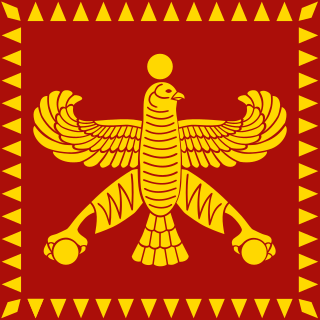
Yehud, also known as Yehud Medinata or Yehud Medinta, was an administrative province of the Achaemenid Persian Empire in the region of Judea that functioned as a self-governing region under its local Jewish population. The province was a part of the Persian satrapy of Eber-Nari, and continued to exist for two centuries until its incorporation into the Hellenistic empires following the conquests of Alexander the Great.
Second Temple Judaism refers to the Jewish religion as it developed during the Second Temple period, which began with the construction of the Second Temple around 516 BCE and ended with the Roman siege of Jerusalem in 70 CE.
Yehud was a province of the Neo-Babylonian Empire established in the former territories of the Kingdom of Judah, which was destroyed by the Babylonians in the aftermath of the Judahite revolts and the siege of Jerusalem in 587/6 BCE. It first existed as a Jewish administrative division under Gedaliah ben Aḥikam, who was later assassinated by a fellow Jew. The Fast of Gedaliah, a minor fast day in Judaism, was established in memory of this event, and is lamented by observant Jews even to this day.
The Jewish state refers to the modern-day state of Israel.

Oded Lipschits is an Israeli professor in the Department of Archaeology and Ancient Near East Studies at Tel Aviv University. In 1997 he earned his Ph.D. in Jewish History under the supervision of Nadav Na'aman. He has since become a Senior Lecturer and Full Professor at Tel Aviv University and served as the Director of the Tel Aviv Institute of Archaeology since 2011. Lipschits is an incumbent of the Austria Chair of the Archeology of the Land of Israel in the Biblical Period and is the Head and founder of the Ancient Israel Studies Masters program in the Department of Archaeology and Ancient Near East Studies.
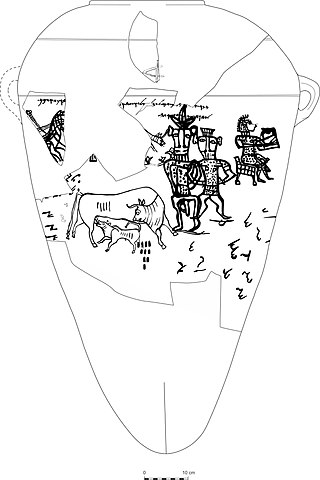
Yahwism is the name given by modern scholars to the religion of ancient Israel. Yahwism was essentially polytheistic, with a plethora of gods and goddesses. Heading the pantheon was Yahweh, the national god of the Israelite kingdoms of Israel and Judah, with his consort, the goddess Asherah, and second-tier gods and goddesses such as Baal, Shamash, Yarikh, Mot, and Astarte, each of whom had their own priests and prophets and numbered royalty among their devotees.












